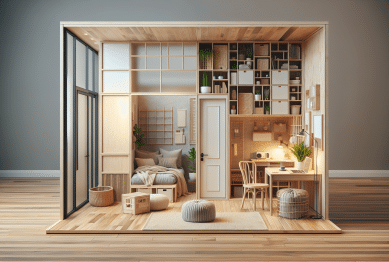Explore how minimalist living can transform your daily routines, help declutter your home, and support mindful choices in spending and decor. Discover new techniques and inspiration for creating a serene, welcoming space and lifestyle focused on what truly matters.
The Minimalist Mindset: Clearing the Mental Clutter
Minimalist living is more than just having fewer possessions. It’s a shift in mindset that encourages conscious decision-making about what to keep in your life. Many people find themselves overwhelmed by both physical and digital clutter, which can cloud judgment and create stress. Adopting minimalist principles helps individuals prioritize what is truly important, leading to greater mental clarity and peace. Taking small steps, like clearing a workspace or deleting unused apps, starts the journey toward a less chaotic mind and environment.
The benefits of minimalism reach into mental health and emotional well-being. When daily life is surrounded by excess, choices become overwhelming and it is easier to feel anxious. Minimalism encourages intentionally choosing what adds value, whether that’s making time for hobbies, forming deeper relationships, or simply enjoying quiet moments. These choices reinforce a sense of purpose and satisfaction, teaching that more isn’t always better. Developing this mindset means assessing needs versus wants on a regular basis.
Decluttering your thoughts can be just as powerful as tidying your home. Practicing mindfulness while evaluating habits and routines can reveal what truly serves you. Journaling, meditation, or deliberately spending time offline support a clear and focused mind. This type of intentional reflection is core to minimalist living and results in a more satisfying, meaningful lifestyle that many modern individuals crave. Over time, you may notice improved concentration, reduced stress, and a greater appreciation for what you already possess.
Declutter Your Home: Room by Room Approach
Physical clutter can accumulate quickly, often without notice. Tackling it with a room-by-room strategy makes the process manageable. Start in areas that impact your daily routine the most: the bedroom, kitchen, or living room. Empty the space, sort items into keep, donate, and discard piles, and return only what you truly need or love. This method prevents overwhelm and provides clear visual progress, which is motivating to maintain. A tidy, minimalist living space is calming and easier to care for in the long run.
Minimalist decor plays a critical role in the overall feel of your space. Opt for quality over quantity by choosing functional pieces that double as design statements. Rely on neutral color palettes, simple lines, and natural materials to foster a sense of peace. Bringing in only intentionally chosen elements keeps surfaces clear and highlights the beauty of open space. The minimalist home is not barren; it is thoughtfully curated and purpose-driven, offering a refreshing escape from the excess often found in modern lifestyles.
Sustaining a minimalist home involves regular habits. Weekly or monthly decluttering reviews ensure that unnecessary items don’t sneak back in. Be mindful about new acquisitions by following a one-in, one-out policy. Even digital minimalism matters — unsubscribe from unwanted emails and organize photos monthly. These ongoing habits safeguard against clutter reaccumulation and support a home environment that feels light, peaceful, and deeply personal. As the space becomes more streamlined, cleaning routines simplify, freeing time for what you love.
Intentional Spending: Save Money With Minimalism
Minimalist living habits directly impact financial wellness. By adopting intentional spending, people learn to distinguish between true needs and fleeting wants. Instead of impulsively buying the latest trend, minimalists pause to consider whether an item serves a real purpose or brings long-term value. This reorientation can result in significant savings over time. Many discover that experiences, such as dining with friends or learning a new skill, provide more lasting joy than material purchases. Mindful budgeting is a natural outcome of this approach.
Adopting a minimalist framework for shopping means prioritizing quality and durability. Rather than stocking up on single-use items, the focus shifts to multi-purpose products and timeless pieces. This applies not only to household goods but also to fashion, technology, and personal gadgets. Investing in fewer, better-made items saves money in the long term by reducing the need for frequent replacements. As a bonus, these choices often contribute to less waste and a smaller environmental footprint.
Intentional minimalism also extends to evaluating recurring expenses: subscriptions, memberships, and even utility usage. Regularly reviewing these commitments prevents unnecessary spending and supports a more streamlined financial life. Many individuals find satisfaction in reallocating saved funds toward travel, self-improvement courses, or savings for future goals. Minimalist living guides people to make every dollar count, align purchases with personal values, and cultivate a deeper sense of financial security.
Minimalist Decor: Style Without Excess
Minimalist decor is a growing trend among homeowners and renters alike who value simplicity and elegance. By focusing on clean lines, uncluttered surfaces, and intentional pieces, spaces feel more restful and inviting. Choosing a small number of standout features — a statement lamp, a single piece of art, or a comfortable chair — allows each detail to shine. Natural light, open floor plans, and gentle accents promote a calming ambiance where relaxation and creativity thrive.
Color is used sparingly in minimalist interiors but can still make a powerful impact. Soft hues such as whites, beiges, and grays form the backdrop, while natural wood or a splash of greenery adds warmth. Textures play a subtle but important role, with cozy throws or tactile ceramics adding comfort without visual chaos. The result is a harmonious atmosphere that encourages reflection and reduces sensory overload, blending style with practical living.
Adapting existing spaces into minimalist sanctuaries doesn’t require extensive renovations. Small changes — removing clutter, exchanging heavy curtains for lighter fabrics, or editing down wall art — can create an immediate sense of openness. Reimagining how each room is used may reveal underutilized areas or inspire multifunctional layouts. Minimalist style, with its timeless appeal, can be adapted to any budget or current furnishings, making serenity accessible for every home.
Mindful Habits: Living With Purpose Every Day
At its essence, minimalist living is about creating space not just in your home, but in your life. Mindful daily habits are key to maintaining this approach. Establishing morning routines, practicing gratitude, and setting boundaries with technology all serve to protect mental and physical energy. Making time for reflection in the form of journaling or quiet walks helps maintain focus and clarity throughout the day, preventing the accumulation of unnecessary distractions.
Practicing digital minimalism is increasingly important as devices and notifications demand attention. Evaluate which platforms genuinely contribute to your happiness or livelihood, and gently let go of the rest. Designate phone-free zones in your home or set aside time each day to disconnect. These practices foster deeper connections with the people and pursuits most important to you, anchoring your lifestyle in real, present experiences instead of constant scrolling or comparison.
Building community and sharing experiences supports a sustainable minimalist journey. Connect with like-minded individuals through discussion groups, online forums, or local workshops. Sharing stories can spark inspiration, provide fresh ideas, and offer encouragement during periods of doubt. As minimalist living evolves from a trend to a personal philosophy, the broader benefits — improved well-being, stronger relationships, and a greater sense of control — reveal themselves over time. The journey is unique for each person, always guided by intention and self-awareness.
Environmental Impact: Minimalism and Sustainable Choices
Minimalist choices often go hand-in-hand with environmental responsibility. By buying less, reusing what you have, and opting for durable products, waste is minimized at the source. Sustainable living practices include using reusable bags, eliminating single-use plastics, and favoring natural materials for home goods. These choices, while sometimes small, collectively create a significant positive effect on the environment. Simplifying consumption helps reduce one’s carbon footprint and preserves resources for future generations.
Supporting ethical brands is another key component of sustainable minimalism. Consider investing in clothing companies that use organic fabrics, or appliances with energy-efficient ratings. This approach not only supports responsible business practices but also brings greater satisfaction in ownership. Many find that when each purchase is intentional, it aligns closely with environmental values and offers a sense of contribution to the wider global community.
Minimalist living can inspire others to adopt similar habits, multiplying the ecological impact. Hosting clothing swaps, sharing decluttering experiences, or mentoring neighbors about composting promotes strong community bonds and extends the movement. When sustainability is combined with purposeful minimalism, the lifestyle feels more rewarding and sustainable for the long haul, reinforcing your personal commitment to planetary well-being as well as individual growth.
References
1. Becker, J. (n.d.). The Minimalist Home: A Room-by-Room Guide. Retrieved from https://www.becomingminimalist.com/minimalism-room-by-room/
2. U.S. Environmental Protection Agency. (n.d.). Sustainable Management of Materials. Retrieved from https://www.epa.gov/smm
3. Mayo Clinic Staff. (n.d.). Stress relief from decluttering: Getting rid of stress by getting rid of stuff. Retrieved from https://www.mayoclinic.org/healthy-lifestyle/stress-management/in-depth/stress/art-20044430
4. Kondo, M. (n.d.). The Life-Changing Magic of Tidying Up. Retrieved from https://konmari.com/about-the-konmari-method/
5. Rosen, L. D., Lim, A. F., Carrier, L. M., & Cheever, N. A. (2014). An Empirical Examination of the Educational Impact of Text Message-Induced Task Switching in the Classroom: Educational Implications and Strategies to Enhance Learning. Retrieved from https://journals.sagepub.com/doi/10.3102/0034654314532699
6. The Minimalists. (n.d.). Minimalism: A Documentary About the Important Things. Retrieved from https://www.theminimalists.com/film/









